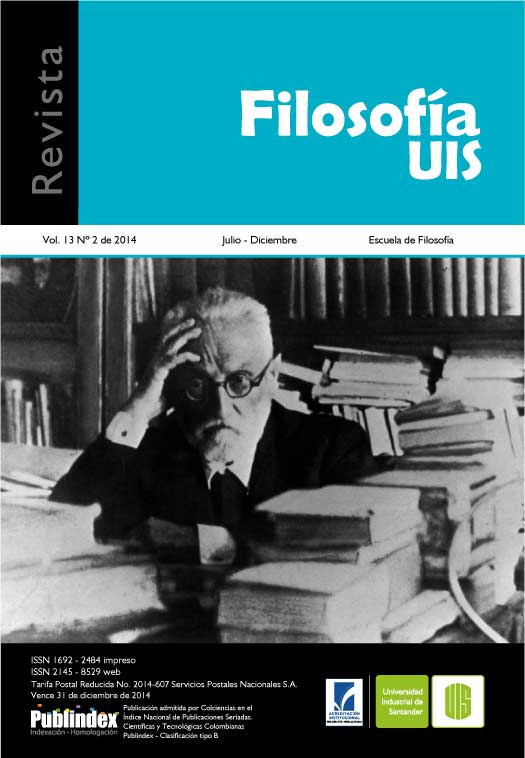Publicado 04-11-2014
Palabras clave
- diferencia antropológica,
- gradualismo,
- Preston,
- Ingold,
- affordance intencional
Cómo citar
Derechos de autor 2015 Andrés Crelier, Diego Parente

Esta obra está bajo una licencia internacional Creative Commons Atribución 4.0.
Resumen
El trabajo defiende una distinción entre dos modos de relación técnica con el entorno, propias de los animales humanos y de los no humanos respectivamente. En primer lugar, se critica una posición naturalista “ecológica” o “contextualista”, que no permite tal distinción, y que se encuentra en autores como Preston e Ingold. En segundo lugar, se introduce la noción de “affordance intencional”, propuesta por Tomasello, para caracterizar la tecnicidad propiamente humana. En tercer lugar, se esbozan los momentos de una concepción gradualista de la técnica que permita a la vez pensar la diferencia específica de la tecnicidad humana.
Descargas
Citas
- Andrews, K. (2012). Do Apes Read Minds? Toward a New Folk Psychology. Cambridge (Mass.) / London: The MIT Press.
- Beck, B. (1980). Animal Tool Behavior: The Use and Manufacture of Tools by Animals. New York and London: Garland STPM Press.
- Beck, J. (2012). “Do Animals Engage in Conceptual Thought?”. Philosophy Compass. Volumen 7 (3). pp. 218–229.
- Boesch, Ch. & B. (1990). “Hedwige, Tool Use and Tool Making in Wild Chimpanzees”. Follia Primatologica. Volumen 54. pp. 86-99.
- Crelier, A. y Parente, D. (2013). “Artifacts, agents and intentions: Towards a reflexive ontology of technical objects”. Ludus Vitalis. Volumen XXI (39). pp. 199-225.
- Crelier, A., y Parente, D. (2011). “La rehabilitación ontológica de los artefactos. Un enfoque “reflexivo””. Agora Philosophica. Volumen 12 (23). pp. 40-51.
- Dipert, R. R. (1993). Artifacts, Art works, and Agency. Philadelphia: Temple University.
- Gibson, J. (1979). The Ecological Approach to Visual Perception. Boston: HoughtonMifflin. 36 Andrés Crelier, Diego Parente
- Gould, J. L. (2007). “Animal Artifacts”. In: Margolis, E. and Laurence, S. (eds.). Creations of the Mind. Theories of Artifacts and Their Representation. Oxford and New York: Oxford University Press. pp. 249–266.
- Ingold, T. (2000). The Perception of the Environment. Essays on livelihood, dwelling and skill. London/New York: Routledge.
- Lawler, D. (2009). “Artefactos técnicos y realización múltiple”. En: Lawler, D. y Vega, J. (eds.). La respuesta a la pregunta. Metafísica, técnica y valores. Buenos Aires: Biblos.
- Mulcahy, N. J., et al. (2006) “Apes Save Tools for Future Use”. Science. Volumen 312. pp. 1038-1040.
- Povinelli, D. J. (2003). Folk Physics for Apes. The Cimpanzees’s Theory of How the World Works. New York: Oxford University Press.
- Preston, B. (1998). Cognition and Tool Use. Mind & Language. Volumen 13 (4). pp 513–547.
- Preston, B. (2013). A Philosophy of Material Culture. Action, Function and Mind. London / New York: Routledge.
- Reynolds, P. C. (1993). “The Complementation Theory of Language and Tool Use”. In: Kathleen R. Gibson and Tim Ingold (ed.). Tools, Language and Cognition in Human Evolution. Cambridge, UK: Cambridge University Press. pp. 407-28.
- Seyfarth, D. L. and Cheney, R. M. (2007). Baboon Metaphysics. The Evolution of a Social Mind. Chicago: The University of Chicago Press..
- Sterelny, K. (2012). The Evolved Apprentice. How Evolution Made Humans Unique. Cambridge (Mass.) / London: The MIT Press.
- Tomasello, M. (1999). The Cultural Origins of Human Cognition. Cambridge (Mass.) London: Harvard University Press.
- Tomasello, M. (2008). Origins of Human Communication. Cambridge (Mass.) / London: The MIT Press.
- CIBERGRAFÍA
- Goodall, J. (n.d.). Recuperado el 30 de Octubre de 2013, de: http://www. janegoodall.es/es/gombe50.html
